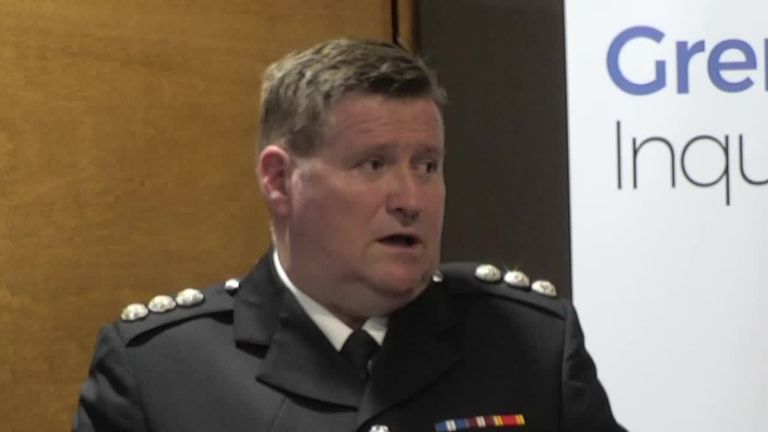Grenfell Inquiry: What have we learned from firefighters' evidence?

Tuesday 2 October 2018 22:32, UK
After months of emotional hearings, the Grenfell Inquiry has reached the end of another stage of hearings.
Since June, the inquiry has been hearing evidence from the London Fire Brigade on the outbreak of the fire and the rescue effort, conditions of the building, and the decisions that guided what happened that night.
Eighty LFB staff shared their experience, with more providing written evidence.
What have we learned from their testimonies?
Was the cladding to blame?
Concerns over the material used on the outside of the tower had been raised before the fire happened, and quickly became a focus of the investigation.
One of the first firefighters to respond described the building as having gone up like a "Roman candle", adding that the flames appeared to be a white colour that indicated chemicals burning.
Colleague Charles Batterbee said he would "never in a million years" have expected to find sandwich panels in a residential block.
Some firefighters felt that a lack of knowledge about how the blaze would behave led to misjudgements - but others believed crews would have been unable to keep up with its rapid spread no matter how many were on the ground.
Why did residents "stay put"?
The stay put policy, which advised residents to remain in their apartments, was based on an understanding that fire would not spread between compartments in a building.
Expert reports and guidance had said the policy should be abandoned in some circumstances, and concluded after the fire that the death toll may have been lower if the building was evacuated.
But "stay put" remained in place even as the blaze spread far beyond the flat where the fire started. By the time residents were told to evacuate at 2.47am it was too late to get out.
This has led many to question whether the policy should be changed. LFB commissioner Dany Cotton, however, has rejected the idea that abandoning it would make a difference, as narrow stairwells would have impeded evacuation.
Communication on the night was enormously difficult
Firefighters said they were dealing with an unprecedented number of 999 calls and were struggling to keep track, writing information on bits of paper and using the phones of residents to speak to those trapped inside.
When decisions were made from above it was sometimes difficult to communicate changes to people on the ground.
Watch manager Norman Harrison said he communicated that an evacuation was needed in a "very direct and unequivocal" manner, but that he was not acknowledged.
It was also difficult to get accurate information from crews who left the building, as some were suffering from heat or lack of oxygen, and sparse information about those trapped was communicated to the control room.
But it is believed more than 60 residents were still saved as a result of information that was passed to crews.
Were personnel properly trained?
Many of the firefighters on duty at the time of the fire said they were unprepared for the blaze.
Watch manager Michael Dowden was among those who felt out of his comfort zone - explaining that he had "no previous knowledge" of cladding on the building.
He also said he could not remember going on a training course about when abandoning the stay put policy might be necessary.
Ms Cotton also said she had no training on revoking stay-put orders or cladding fires.
But she said training for a scenario like Grenfell would have been unrealistic - like developing "a training package for a space shuttle to land in front of the Shard".
It also emerged that a training exercise, due to take place at Grenfell days before the fire, was cancelled, and that plans of the building used in the blaze dated back to 2009, before the building was refurbished.
Escape routes
Access in and out of the building was a huge challenge for fire crews.
The fact that there was only one central staircase impeded rescue efforts and meant residents struggled to escape.
And with no working lift, fire crews packed into the stairwell making it difficult to either escape or get help, including cumbersome firefighting equipment, into the building.
More problems resulted from a key fob system that automatically locked the foyer door, making it difficult for firefighters to enter.
Trauma of the night
As they fought to rescue the people trapped inside, the firefighters working on the night of the fire were faced with an impossible decision.
Christopher Batcheldor said he spoke to trapped mother Zainab Deen on the phone, telling her that firefighters were coming to save her.
But he knew no help was on its way, and listened to sobbing and "ear-splitting screams" as her two-year-old son, then Zainab herself, died.
Stories of heroism were also shared by the firefighters who dragged survivors from the tower.
David Badillo, part of the first crew to get to the fire, said he was on a "personal mission" to save Jessica Urbano Ramirez from the fire.
But the 20-year LFB veteran did not know the girl had left her flat to take shelter on a higher floor.
In the month after they found her body, Mr Badillo said he "cried every day".









